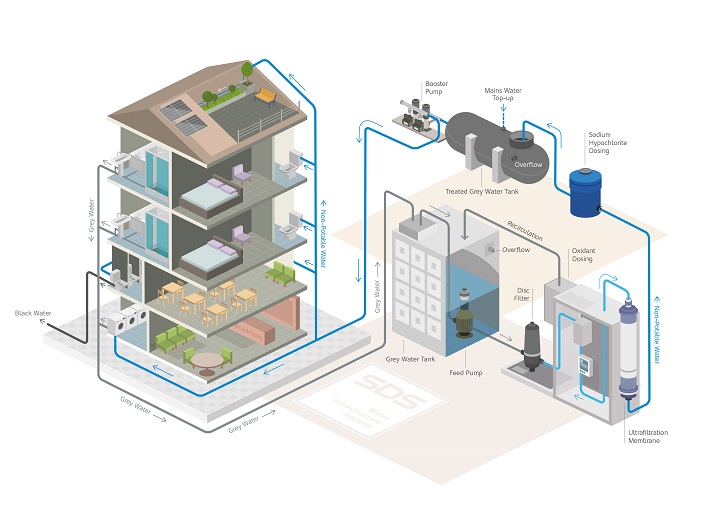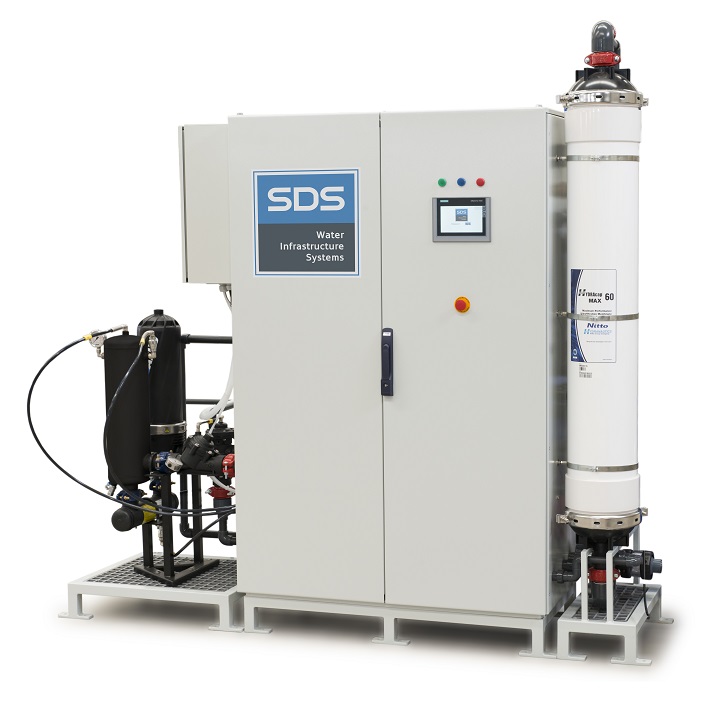


A next-generation water recycling system, unveiled by water infrastructure systems’ specialist SDS, uses the latest ultrafiltration technology, unique to the UK, together with smart controls, to deliver a space-saving, low-energy and responsive water reuse system, for commercial buildings and hotels.
The SDS Greywater on Demand (GWOD) system promises to boost business sector efforts to save water by offering significantly improved investment returns for commercial developers and operators.
The water recycling system is set to be a flagship technology of the company’s water reuse product range. It is also one of the first to be equipped with SDS’s SYMBiotIC automated smart controls incorporating Cloud-based monitoring to ensure that process performance is optimised.
The GWOD’s small footprint, together with its ability to provide on-demand, quality recycled water whenever needed, makes it capable of significantly improved investment payback when compared to conventional Membrane Bioreactor (MBR) greywater systems, especially for larger-scale systems.
SDS water recycling specialist Kevin Reed explains: “In the past, MBR systems have tended to be the technology of choice. Our ultrafiltration system typically processes water at about 2 m3 per hour per filter, compared to an MBR system which processes at about 4 m3 per day per membrane. As a result of the faster treatment and storage volume, the tank size is considerably smaller than for a typical MBR system.
Responsive reuse system “Using ultrafiltration also makes the system responsive to demand at peak times. Unlike MBR, our system does not depend on having to build up a biomass of bacteria for peak operation. High quality water is available immediately on start up. This also means that the system can be shut down when not in use, for example in an office block at weekends or holidays. In this way the system saves energy, too.”
The SDS Greywater on Demand system can pay back in as little as seven years, although actual return on investment will depend on the size of the system and the local water company charges. SDS offers a full design and installation service to support public health engineers, developers and commercial operators and ensure correct system sizing for maximum savings.
How it works In the GWOD system, greywater is collected and then pumped through a disk pre-filter system and dosed with a small amount of chlorine before entering the ultrafilters. The treated water is then stored, ready for use, in a separate tank and pumped, as needed, around the building. The GWOD’s ultrafiltration system is a highly efficient membrane with automated integral backwash, that delivers treated water to near drinking water standards. The compact design can be adapted to add as many ultrafilters as required to deliver the amount of recycled water needed to service the building.
Cloud-based monitoring When combined with SDS’s smart SYMBiotIC Cloud-based data monitoring and control, SDS GWOD can be configured to provide real-time performance measures, condition monitoring with alarms and alerts, as well as trend mapping to aid with preventative maintenance. Regular reports of water saving performance can also be output.
Greywater is wastewater, for example, from baths, showers and handbasins, that can be filtered, treated and then reused for non-drinking purposes such as toilet flushing, laundry or garden irrigation. The principle is already being widely adopted, especially by hotels and large office blocks. In London, where planning laws encourage water recycling, up to 20% of new buildings include greywater reuse systems.
Reed continued: “With the impact of climate change, increased periods of drought and water stress are predicted. So, it will be imperative for sustainable buildings to adapt and install water saving measures as standard. Up to 60% of the water used in commercial buildings, such as office blocks or hotels, is highly treated drinking water that is used, wastefully, to flush toilets or irrigate gardens, where the level of treatment is simply not needed. More cost-efficient reuse of water will benefit water companies by decreasing the demand on an already stressed supply network.
“Any technology must first demonstrate it is commercially viable, before its environmental benefits can be exploited. New technologies like ultrafiltration and smart controls can lead the change, by making water reuse systems more accessible and attractive commercially.”
The launch of the SDS Greywater on Demand system follows on from the company’s acquisition of the water recycling business of established industry leader Waterscan in 2019.






